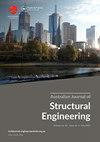砌体结构的损伤限制和结构性能系数
IF 1.3
Q4 ENGINEERING, CIVIL
Australian Journal of Structural Engineering
Pub Date : 2021-01-02
DOI:10.1080/13287982.2021.1872978
引用次数: 3
摘要
不同的规范为不同的砌体建筑系统提供了一系列的结构性能系数值。不同规范的结构行为因素差异很大,主要是由于缺乏实验研究的信息。因此,本文强调通过对砌体建筑进行循环位移的全尺寸试验来研究不同砌体结构系统的行为。进行了六次试验,其中三次是在原始砌体建筑系统上进行的,采用了具有相似几何、材料、结构特征和试验程序的无增强砌体(URM)、增强砌体(RM)和约束砌体(CM)。其余三种测试的建筑模型包括修复的未加固砌体(URM-REP),改造的未加固砌体(URM-RET)和改造的加固砌体(RM-RET)。从实验中得到的观察和数据将损伤指数、损伤等级和位移能力相互关联,从而估计不同砌体建筑类型的结构行为因子。分析表明,规范中结构性能因子的取值范围对于URM和RM是足够的,而对于CM的取值范围是保守的,可以放宽。此外,人们还注意到,修复和改造后的砖石结构的结构性能系数大幅增加,从而证明了改造措施在结构上的适当性。本文章由计算机程序翻译,如有差异,请以英文原文为准。
Damage limitation and structural behaviour factor for masonry structures
ABSTRACT Different codes provide a range of values for structural behaviour factor for various masonry building systems. High variation in structural behaviour factors in different codes arises mainly due to the lack of information from experimental studies. Thus, the present paper highlights investigation of behaviour of different masonry construction systems through full-scale tests on masonry buildings subjected to cyclic displacement. Six tests, out of which three on virgin masonry building systems, employing unreinforced masonry (URM), reinforced masonry (RM) and confined masonry (CM) having similar geometrical, material, constructional features and test procedures were conducted. The remaining three building models tested included repaired unreinforced masonry (URM-REP), retrofitted unreinforced masonry (URM-RET) and retrofitted reinforced masonry (RM-RET). Observations and data from the experiments have been co-related between damage index, grade of damage and displacement capacity, thereby estimation of structural behaviour factor for different masonry building typologies. The analysis shows that the ranges of structural behaviour factor mentioned in codes are adequate for URM and RM, while the same for CM is conservative, which can be relaxed. Also, it has been noticed that there is a substantial increase in structural behaviour factor for repaired and retrofitted masonry structures, thus proving the structural adequacy of retrofitting measures.
求助全文
通过发布文献求助,成功后即可免费获取论文全文。
去求助
来源期刊

Australian Journal of Structural Engineering
ENGINEERING, CIVIL-
CiteScore
2.50
自引率
0.00%
发文量
31
期刊介绍:
The Australian Journal of Structural Engineering (AJSE) is published under the auspices of the Structural College Board of Engineers Australia. It fulfils part of the Board''s mission for Continuing Professional Development. The journal also offers a means for exchange and interaction of scientific and professional issues and technical developments. The journal is open to members and non-members of Engineers Australia. Original papers on research and development (Technical Papers) and professional matters and achievements (Professional Papers) in all areas relevant to the science, art and practice of structural engineering are considered for possible publication. All papers and technical notes are peer-reviewed. The fundamental criterion for acceptance for publication is the intellectual and professional value of the contribution. Occasionally, papers previously published in essentially the same form elsewhere may be considered for publication. In this case acknowledgement to prior publication must be included in a footnote on page one of the manuscript. These papers are peer-reviewed as new submissions. The length of acceptable contributions typically should not exceed 4,000 to 5,000 word equivalents. Longer manuscripts may be considered at the discretion of the Editor. Technical Notes typically should not exceed about 1,000 word equivalents. Discussions on a Paper or Note published in the AJSE are welcomed. Discussions must address significant matters related to the content of a Paper or Technical Note and may include supplementary and critical comments and questions regarding content.
 求助内容:
求助内容: 应助结果提醒方式:
应助结果提醒方式:


